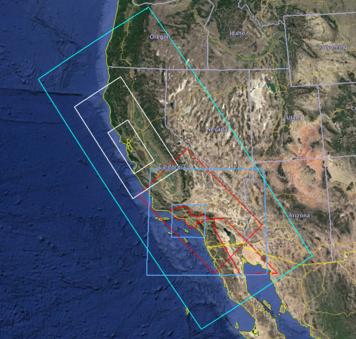UCVM
The Unified Community Velocity Model (UCVM) software framework is a collection of open-source scientific software tools designed to support earth scientists, civil engineers, and other groups interested in detailed information about earth properties. The seismic velocity models currently available through UCVM are primarily California high resolution regional scales seismic velocity models that provide Vp, Vs, and density for a defined geographic volume for a region. One important use of UCVM is by researchers performing high resolution 3D wave propagation simulations of California and other regions.
Contents
Current UCVM Software Releases
The current version is UCVM v22.7.0, which was released in November 2022.
UCVM Documentation
UCVM documentation is located on the UCVM github wiki:
UCVM Installation Options
UCVM was developed to support seismic simulations run on high-performance computing systems, so it is designed to compile and run on Linux-based computers. Before installing UCVM, they should be aware that there are several ways to get access to UCVM without installing the software on your own Linux computer. Below we outline several of the options:
- SCEC UCVM Web viewer: Users can query UCVM velocity models, without installing UCVM, using the UCVM website.
- UCVM Docker Images: Users can run UCVM in Docker on their local computers including laptops. Users can install free Docker software on most computers (e.g. Linux, MacOS, Windows) then run an UCVM Docker image in a terminal window on their computer.
- Installation Instructions for Linux Systems: User can install UCVM on Linux system. Advanced users that want to install many of the UCVM models, or that want to run large parallel queries of the CVM models, should install the UCVM software on a Linux system. UCVM software is developed on USC Center for Advanced Research Computing (CARC) Linux cluster which provide MPI libraries. The UCVM software framework has several MPI-based executables. These executables are built using the automake system if the required MPI libraries are found in the installation computing environment.
UCVM Introduction
The Unified Community Velocity Model (UCVM) software is open-source scientific software designed to support earth scientists, civil engineers, and other groups interested in detailed information about earth properties. UCVM is primarily used by scientists to work with earth material properties on regional scales.
UCVM software provides a software interface to one or more existing earth structure models. Researchers may choose to use the UCVM software, in order to access one or more UCVM specific capabilities, which include:
- Provides standard query interface to multiple CVM models with different projections.
- Converts query by elevation to query by depth to create comparable models.
- Provides standard methods for tri-linear interpolation, Vs30, and basin query from models.
- Provides plotting and analysis tools that make vertical profile, horizontal, and cross section plots.
- Provides tools to add geotechnical layers and small scale heterogeneities into models.
- Supports tiling of models and background models.
- Make AWP and ETree format meshes including parallel extractions.
Preferred UCVM Software Reference
If you use the UCVM software in your research, please include a reference to this software. References help us obtain continued support for the software development of this code. The preferred reference for the UCVM software is:
- Small, P., Gill, D., Maechling, P. J., Taborda, R., Callaghan, S., Jordan, T. H., Ely, G. P., Olsen, K. B., & Goulet, C. A. (2017). The SCEC Unified Community Velocity Model Software Framework. Seismological Research Letters, 88(5). https://doi.org/doi:10.1785/0220170082
